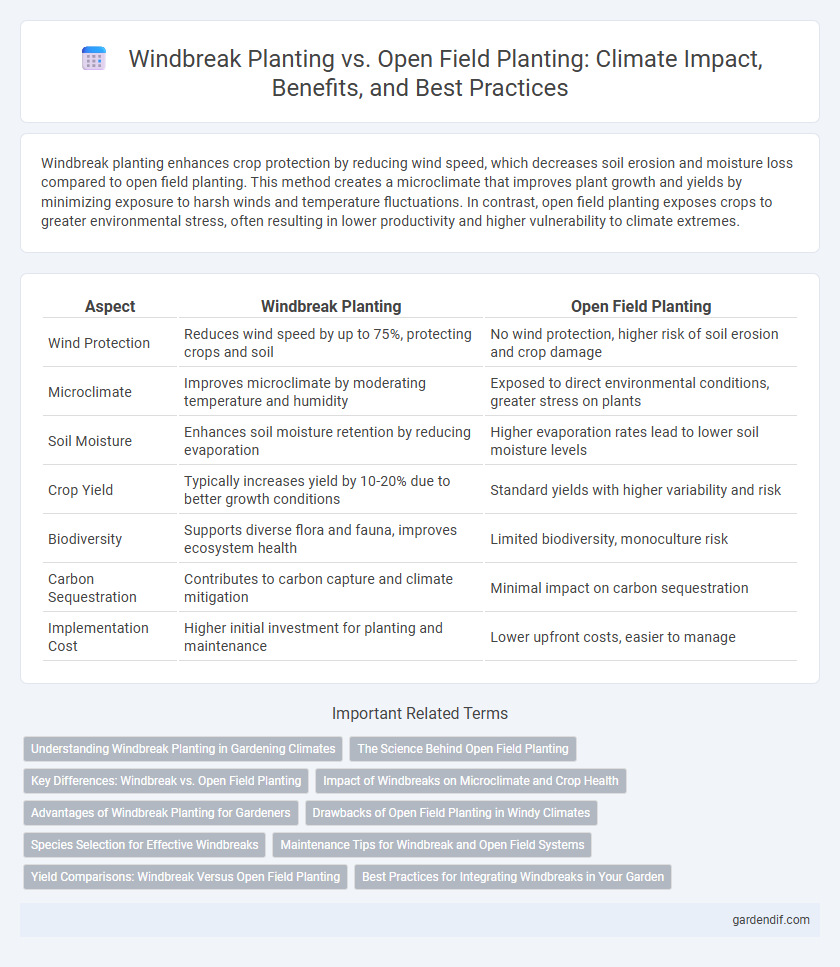
Windbreak planting vs open field planting Illustration
Windbreak planting enhances crop protection by reducing wind speed, which decreases soil erosion and moisture loss compared to open field planting. This method creates a microclimate that improves plant growth and yields by minimizing exposure to harsh winds and temperature fluctuations. In contrast, open field planting exposes crops to greater environmental stress, often resulting in lower productivity and higher vulnerability to climate extremes.
Table of Comparison
| Aspect | Windbreak Planting | Open Field Planting |
|---|---|---|
| Wind Protection | Reduces wind speed by up to 75%, protecting crops and soil | No wind protection, higher risk of soil erosion and crop damage |
| Microclimate | Improves microclimate by moderating temperature and humidity | Exposed to direct environmental conditions, greater stress on plants |
| Soil Moisture | Enhances soil moisture retention by reducing evaporation | Higher evaporation rates lead to lower soil moisture levels |
| Crop Yield | Typically increases yield by 10-20% due to better growth conditions | Standard yields with higher variability and risk |
| Biodiversity | Supports diverse flora and fauna, improves ecosystem health | Limited biodiversity, monoculture risk |
| Carbon Sequestration | Contributes to carbon capture and climate mitigation | Minimal impact on carbon sequestration |
| Implementation Cost | Higher initial investment for planting and maintenance | Lower upfront costs, easier to manage |
Understanding Windbreak Planting in Gardening Climates
Windbreak planting enhances microclimate control by reducing wind speed, thereby lowering soil erosion and moisture loss compared to open field planting. Strategic selection of tree and shrub species suited to local climate zones maximizes protection for crops, improves pollination efficiency, and supports biodiversity. Incorporating windbreaks in gardening climates promotes sustainable agricultural practices and increases crop resilience against climate fluctuations.
The Science Behind Open Field Planting
Open field planting leverages natural wind patterns to enhance air circulation, reducing humidity and the risk of fungal diseases in crops. This method encourages stronger root systems and improved nutrient uptake due to unobstructed sunlight and airflow. Scientific studies show that open field planting can increase photosynthetic efficiency and crop yield by optimizing microclimate conditions.
Key Differences: Windbreak vs. Open Field Planting
Windbreak planting involves strategically placing rows of trees or shrubs to reduce wind speed, protect crops, and minimize soil erosion, while open field planting exposes crops directly to natural wind conditions, which can increase moisture loss and physical damage. Windbreaks create microclimates that enhance plant growth by regulating temperature and humidity levels, whereas open field planting relies solely on ambient climate factors without such protection. The presence of windbreaks also improves soil moisture retention and can increase agricultural yield compared to open field planting.
Impact of Windbreaks on Microclimate and Crop Health
Windbreak planting significantly alters the microclimate by reducing wind speed, thereby lowering evapotranspiration rates and improving soil moisture retention compared to open field planting. This microclimatic modification enhances crop health by decreasing physical damage from wind stress and promoting stable temperature and humidity conditions. Studies show that windbreaks contribute to increased crop yield and resilience against climate extremes by mitigating environmental stressors.
Advantages of Windbreak Planting for Gardeners
Windbreak planting reduces soil erosion and conserves moisture, creating a more stable microclimate that enhances plant growth. By blocking strong winds, windbreaks protect delicate crops from physical damage and reduce transpiration stress, leading to higher yields. This method also improves biodiversity by providing habitats for beneficial insects and birds, supporting a healthier garden ecosystem.
Drawbacks of Open Field Planting in Windy Climates
Open field planting in windy climates exposes crops to increased wind stress, causing physical damage such as broken stems and desiccation. The lack of natural windbreaks leads to soil erosion and moisture loss, reducing soil fertility and crop yield. Windborne pests and diseases also spread more easily, exacerbating crop vulnerability and limiting productivity.
Species Selection for Effective Windbreaks
Selecting windbreak species requires prioritizing native, fast-growing trees and shrubs with strong root systems to withstand high wind pressures and reduce soil erosion effectively. Species such as eastern red cedar, black locust, and hybrid poplars are commonly used due to their dense foliage and adaptability to various soil conditions in open wind-exposed environments. Proper species selection enhances microclimate regulation, protects crops from wind damage, and supports biodiversity within agricultural landscapes.
Maintenance Tips for Windbreak and Open Field Systems
Proper maintenance of windbreak systems involves regular inspection for pest damage, timely pruning to ensure airflow, and soil moisture monitoring to promote tree health, which significantly enhances their climate resilience. Open field planting requires consistent weed control, nutrient management through soil testing and fertilization, and irrigation scheduling tailored to crop water needs to optimize growth under variable climatic conditions. Both systems benefit from adaptive strategies that mitigate climate stress and improve overall vegetative productivity.
Yield Comparisons: Windbreak Versus Open Field Planting
Windbreak planting can enhance crop yield by reducing wind speed, which minimizes soil erosion and moisture loss compared to open field planting. Studies show that windbreaks increase yield by up to 20% in exposed areas due to improved microclimate conditions. Open field planting lacks these protections, often resulting in lower productivity under high-wind conditions.
Best Practices for Integrating Windbreaks in Your Garden
Windbreak planting enhances garden microclimate by reducing wind speed, preventing soil erosion, and conserving moisture, leading to healthier plant growth compared to open field planting. Selecting a diverse mix of native tree and shrub species with varying heights creates an effective barrier that fosters biodiversity and supports pollinators. Proper spacing and orientation of windbreaks, aligned perpendicular to prevailing winds, maximizes wind protection while maintaining sunlight exposure essential for crop productivity.
Windbreak planting vs open field planting Infographic

 gardendif.com
gardendif.com